Gun rights are winning and nobody has realized it
Many culture wars play out as a disagreement over where things are headed. Gay rights will fade into history vs. gay rights are the future. Governments of the future will enforce separation of the races vs. governments of the future will treat all people equally. Women should stay in their place vs. women will have no one "place" they have to stay. Etc.
Guns aren't like that.
On guns, both sides pitch the same narrative: the lights are going out on gun rights. Everytown says gun control is the right side of history. The NRA, in its own way, signal-boosts that narrative, reminding us constantly of the states — California, New Jersey, etc. — where the gun control ratchet clicks ever tighter. Another year, another election, another law passed. Gun rights cling on, an anachronism in their own time. Until eventually the very concept of "gun rights" slips into the past, like bloodletting, or executing horse thieves — a bizarre, vaguely funny relic from an antique land. That's the story both sides tell their members.
And they're all wrong.
Gun rights are quietly winning on the ground in the vast majority of the US. Yes, there are some major exceptions to that, and we will talk about them. But as we go point by point, a picture will start to emerge of something happening here that everybody is missing.
What's the evidence that everybody's missing it? One strong piece of evidence: all of you are shaking your head at this point in the essay. I know what you're thinking. The gun rights people are thinking, "What do you mean gun rights are winning? What about California? New York? Life in prison for a bump stock in Massachusetts? We're getting crushed." And the gun control people are thinking, "The US is the only country in the world where gun rights are even still a thing. How much longer do you think you can hold on? It's over, history is leaving without you."
Don't worry, we're going to address both of those. But first, let's talk about polls.
Polls
We've all seen these headlines: "Gun control support surges in polls" (Politico), "Gun control support has surged to its highest level in 25 years" (Time), etc.
The headlines have something in common, though. They're based on polls taken immediately after — within a couple weeks, or even sometimes a couple days — of a particularly media-saturating mass shooting. (A recent study of mass shooters from 2013 to 2017 found they had received media coverage worth $75 million.)
Gallup has decades worth of polling data on guns. And when you zoom out, the signal is clear: we are in the middle of a multi-decade decline in support for gun control, with occasional temporary upticks after a mass shooting.
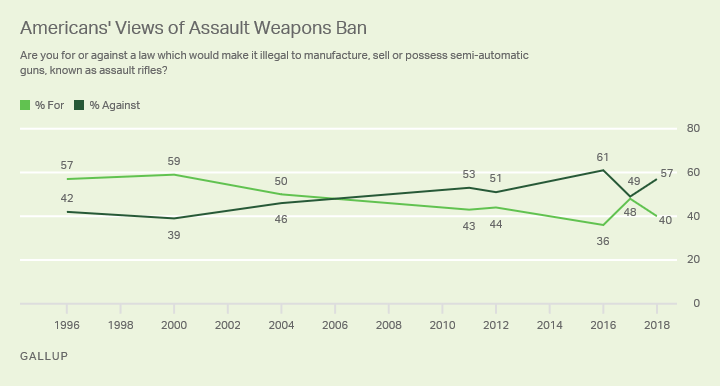
The Pew Research Center has polling data going back to 1993. The question: "What do you think is more important — to protect the right of Americans to own guns, or to control gun ownership?" In all the graphs below, the solid lines are for "Protect gun rights" and the faded lines are for "Control gun ownership".
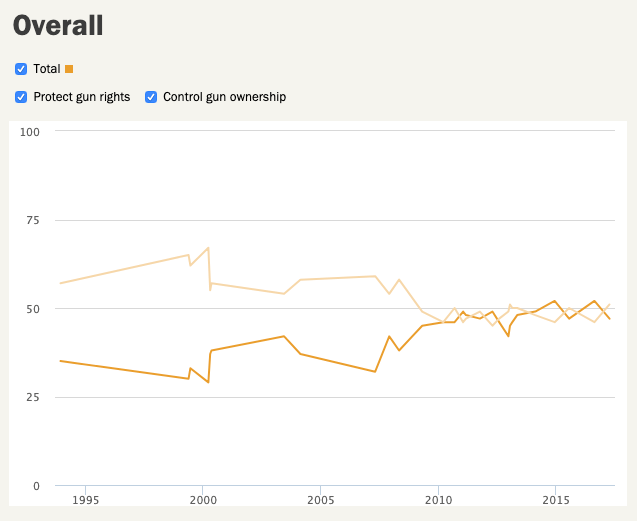
Short-term fluctuations notwithstanding, that's a long-term secular trend towards gun rights and away from gun control. What if we don't average everyone's attitudes together? What if we segment responses by, say, gender?
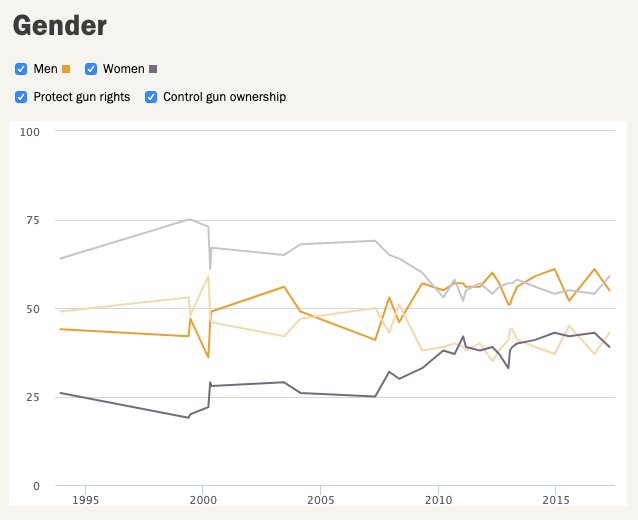
Same trend for women and men — more support for gun rights, less for gun control. How about slicing by age group?
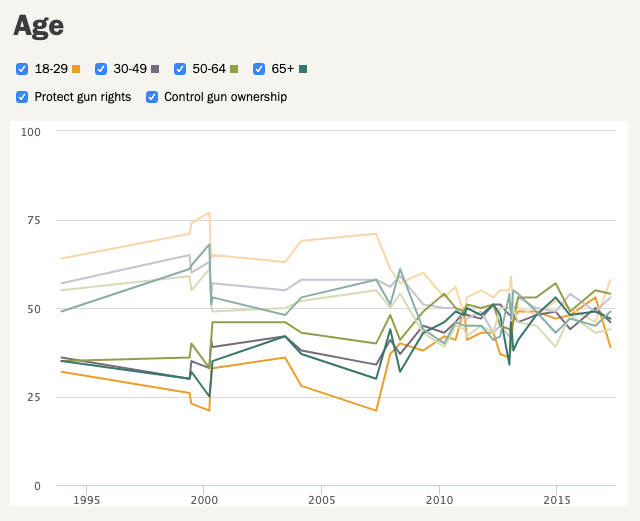
Same trend across all age groups. Young people's movement on this has been particularly pronounced. Until the mid-2000's, they were significantly less supportive of gun rights and more supportive of gun control than older age groups were. In the past decade, that gap has vanished.
There's been some interesting writing on this subject in the past 1-2 years:
- "Millenials Are No More Liberal on Gun Control Than Elders, Polls Show" (NPR, 10 days after the Parkland shooting)
- "Are Millenials Moving Right on Guns?" (Politico, 11 days after the Las Vegas shooting)
(Side note: both articles attempt to map gun control and gun rights onto a vanilla left-right political axis. That binary model is increasingly useless at describing real people's cultural and political beliefs, so the articles end up flummoxed and describe the polling as confusing or contradictory. The better explanation is that it's badly outdated to think that gun rights are right-wing and gun control is left-wing. Assuming that gun rights supporters are all right-wingers is naturally going to be confusing, because it doesn't match reality.)
Okay, how about slicing by race?
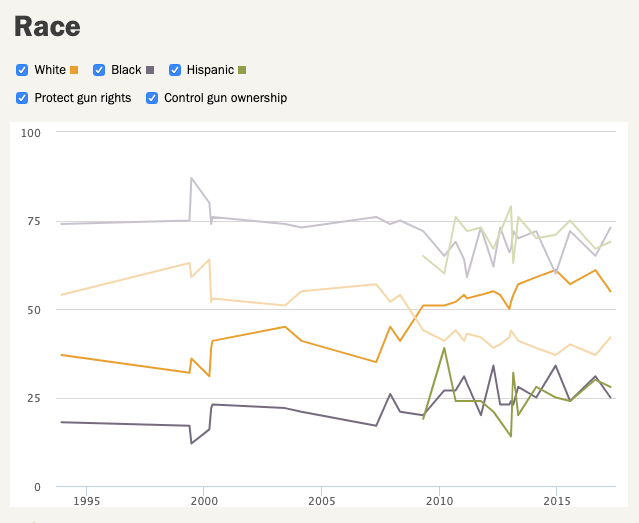
Almost the same trend across all three races in the polling sample, with the exception that the trend is roughly flat among Hispanics. How about slicing by education level?
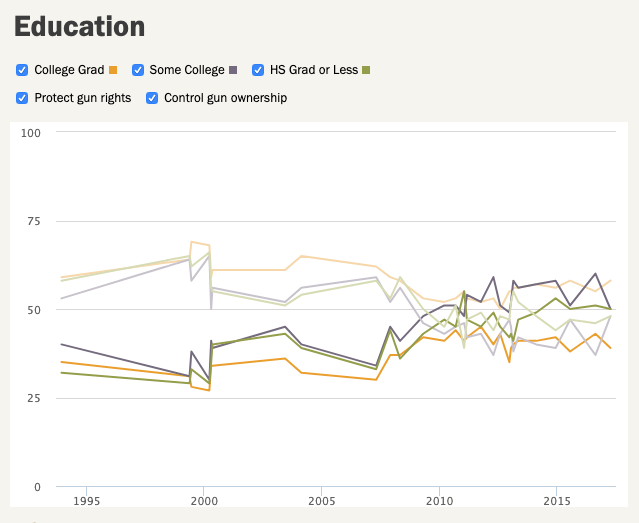
Same trend. How about slicing by political affiliation?
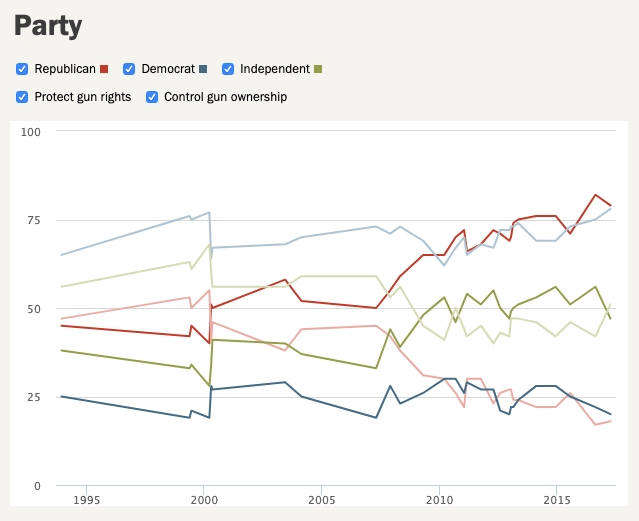
Democrats' trend is roughly flat, maybe a touch towards "control gun ownership", and all other lines follow the trend in the other graphs. Pew has a lot more of these, so let's just do one more and end it: let's slice by whether people have guns in the house.
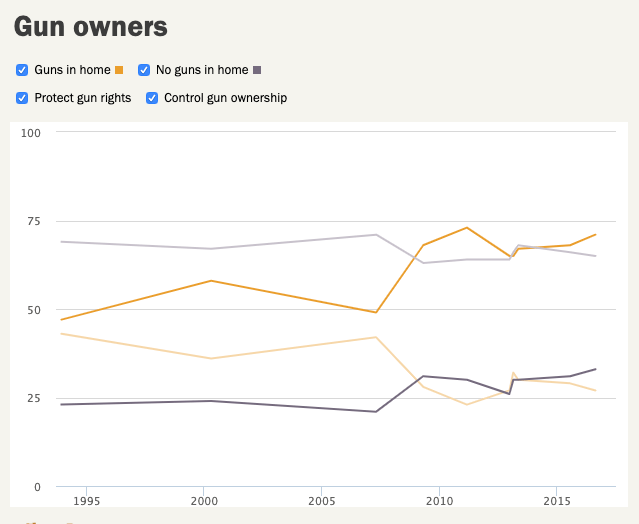
Even among people who don't own guns, there is a multi-decade trend towards gun rights.
This trend holds in almost every graph that Pew has data for. Reports you see to the contrary almost always either:
- Take a snapshot of the data within a couple weeks of a horrific mass shooting, without mentioning that the polling data reverts to the long-term trend within a month or two.
A 2016 study in Frontiers in Public Health (not a publication that has any reason to be gun-rights-friendly) found that after a mass shooting, the media becomes something like a pop-up gun control advocacy group. From the paper's abstract: "Gun violence is related to substantial morbidity and mortality with surrounding discussions framed and shaped by the media. This study’s objective was to explore national news media’s reporting of gun violence around a mass shooting. National news pieces were coded according to categories of gun violence, media frames, entities held responsible, responses, and reporting of the public heath approach. Individuals were held responsible for gun violence in 63% of pieces before and 32% after the shooting. Lawmakers were held responsible in 30% of pieces before and 66% after. Background checks were a proposed gun violence prevention method in 18% of pieces before and 55% after Sandy Hook, and lethality reduction of firearms was in 9% before and 57% after. Following a mass shooting, the media tended to hold government, not individuals, primarily responsible. The media often misrepresented the real picture of gun violence and key public health roles."
Combined with Adam Lankford's findings of $75 million worth of media coverage for mass shooters, it's natural that this all has an effect on polling numbers. What is surprising, and supports this idea of a multi-decade trend towards gun rights, is that the media saturation's effects evaporate within a month or two. - Focus on extremely broad legislative proposals (e.g. "Would you favor or oppose background checks on all potential gun buyers?", which polled at 90% support) and elide the fact that support looks very different when you ask about specifics (e.g. "How worried are you that something like comprehensive background checks or a national gun ownership database would be used by the federal government to monitor other activities of American citizens: very worried, somewhat worried, not too worried, or not at all worried?", which polled at 51% either very worried or somewhat worried).
Okay, so that's the polling settled. There's a long-term secular trend towards gun rights. Let's move on to other evidence.
Concealed carry has completely and utterly won
In a pinch, you could shorten this entire essay down to this one animation:
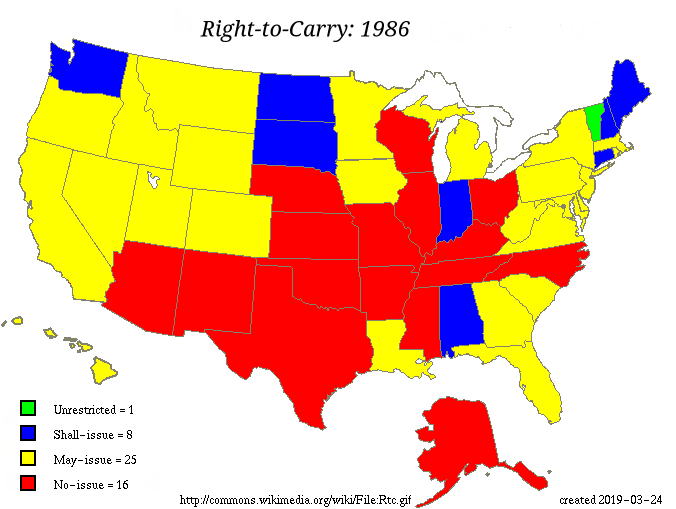
Number of states with each type of carry law in 1986:
- Constitutional carry: 1
- Shall-issue: 8
- May-issue: 25
- No-issue: 16 (including, interestingly, most of the south)
And how it looks today in 2019:
- Constitutional carry: 16
- Shall-issue: 26
- May-issue: 8
- No-issue: 0
That is what a cultural landslide looks like. The natural challenge is, "What about the eight holdout states?" And the answer is that in the long-run, they don't matter. They're called holdout states because they're holding out, which is another way to say they're losing the argument in slow motion. There is no such thing as a tidal wave that hits 42 states and doesn't eventually make it to all 50.
When the Supreme Court legalized same-sex marriage nationally, only 16 states had already legalized it via their legislatures. And even at that stage the path of history was already obvious. (Another 22 states had legalized it via court rulings, but I'm focusing on the legislative victories here because, by design, they're a more direct reflection of cultural sentiments than a court is.)
About 17.25 million people in the US have carry permits. That's 7.14% of the adult population. And that undercounts the number of people who can carry, because 40 million people live in states with constitutional carry. California and New York alone make up 70% of the US population still under may-issue regimes. For everyone living in the other 48 states, 90.6% already have shall-issue or constitutional carry.
(Side note: even the may-issue states aren't as may-issue as they seem. In California, New York, and Massachusetts, the decision to issue a permit is left to local authorities. And in those states, the vast majority of counties decide to be effectively shall-issue. In Delaware and Rhode Island, the law is technically may-issue but is applied as effectively shall-issue. That leaves Hawaii, New Jersey, and Maryland as the only truly may-issue states.)
The demographics look different than most people expect, too. On page 24 of the study linked above, the author finds that for the states that make gender breakdowns available, on average 26% of permit holders are women. He continues:
In the eight states where we have data by gender for both 2012 and 2018, the number of permits increased by 207% for women and by 103% for men –– a 101% faster rate among women.
Five states have data on permit issuance by race for 2012 and 2018. In these states (Arizona, Connecticut, Florida, Oklahoma, and Texas) the number of permits grew at a 20% faster rate for blacks than for whites.
Several states provide detailed data since 2002 or earlier. Texas provides detailed information on both race and gender from 1996 through 2014. The data indicate that permitting has increased fastest among blacks, followed closely by Asians. While whites still hold the vast majority of permits, the number of black permit holders has grown more than twice as quickly as the number of white permit holders.
After Texas reduced its minimum training hours from ten to four in 2012, the growth in permit-holding by Asians, blacks, and American Indians reached by far its most rapid phase. While the number of blacks with permits grew by 71% in the four years prior to the reduced training requirement, it grew by almost 140% in the four years after 2012. The growth rate of permits for American Indians also doubled after the training requirements were reduced.
When permit data is broken down by race and gender, we find that rates of permit holding among American Indian, Asian, black, and white females all grew much faster than the rates for males in those racial groups. Concealed carry has increased most rapidly among black females. From 2000 to 2016, the rate of growth was 2.22 times faster than among white females.
Lastly, a practical legal reality: the Supreme Court is probably going to strike down any remaining carry bans within the next few years. Washington DC's carry ban was struck down by the DC Circuit in 2017, and the city didn't appeal to the Supreme Court because they worried that would give the Court a chance to strike down carry bans nationally. So DC is now shall-issue.
Since that time, the Court has only shifted more towards gun rights. This term, the justices are reviewing cert petitions for two carry cases, Rogers v. Grewal out of New Jersey and Gould v. Lipson out of Massachusetts. And Young v. Hawaii will likely be appealed up to the Supreme Court next year. It's only a matter of time before the justices take one of these cases.
But that's a nitty-gritty legal detail. Culture drives everything else, and from a cultural perspective, we have all the evidence we need that concealed carry is a fait accompli. The game is over, it's just that not everyone knows it yet.
The ever-shrinking ambitions of the gun control groups
Let's start with what they used to be called.
In 1974, a major org started up and called itself the National Coalition to Ban Handguns. Bold, clear, to the point. In 1989, they changed their name to the Coalition to Stop Gun Violence.
A second major org also launched in 1974 under the name the National Council to Control Handguns. A little softer than "ban", but still nice and punchy. In 1980 they changed their name to Handgun Control, Inc. Even better! Bold and aggressive, with a bit of roguish corporate raider flair, ready to tackle the '80s. Perfect, ship it.
But wait, what happened a couple decades later? "In 2001, it was renamed the Brady Campaign to Prevent Gun Violence, and its sister project, the Center to Prevent Handgun Violence, was renamed the Brady Center to Prevent Gun Violence." Why throw away an awesome name like Handgun Control, Inc. just to replace it with some design-by-committee euphemism? Because the name stopped working.
We saw in the polling section above that we're almost 30 years into a long-term secular trend towards gun rights. Platitudes poll well, but gun control doesn't. And the more specific the wording gets, the worse it polls.
So the groups have had to adapt. Stay high-level, and use euphemisms. Their euphemizing is often misinterpreted as sneakiness. It's not, really. In 2019 it's just them doing what's required to be able to attract supporters.
So the evolution of their names is an example of that. Another is the terminology. Here's a snapshot from a genuinely top-quality messaging guide (page 13) prepared by the communications strategist Frank O'Brien, whose client list includes Everytown for Gun Safety:
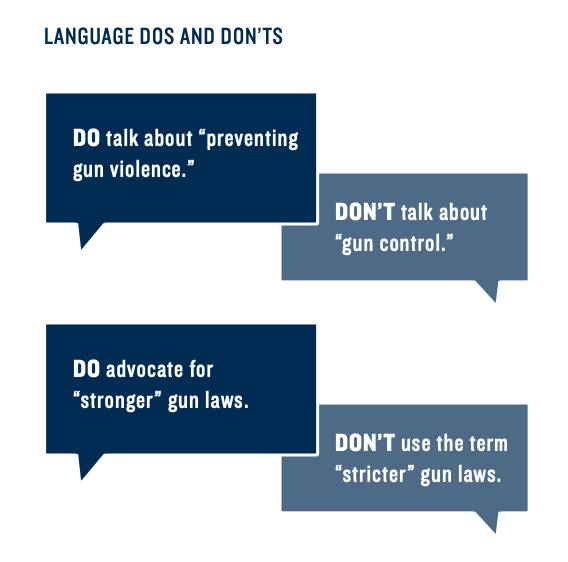
The term used to be "gun control". The public's long-term shift towards gun rights meant that had to change to what we see today. "Gun safety", "common sense gun laws", "gun violence prevention", and "gun reform" are the versions of "gun control" that poll better.
We see this in what people are willing to say in public, too. Cory Booker recently announced the gun control plank of his 2020 platform. It's the normal stuff (licensing, banning standard-capacity magazines and incorrectly-shaped rifle grips, rate-limiting handgun purchases to one per month, etc.), but what's particularly interesting is what it doesn't include: a handgun ban.
In the early 2000s, as a city council member in Newark, NJ, Booker openly supported a handgun ban:
I'm not as interested in his particular beliefs as I am in what his pivot highlights: the facts on the ground have changed. In 2002, a politician could support a handgun ban. In 2019, that is political seppuku, even as a Democrat running for president.
Another example: Dianne Feinstein on 60 Minutes in 1995, regretting that she couldn't get the votes to make the 1994 assault weapons ban confiscate all affected weapons instead of grandfathering in the pre-existing owners.
No major politician or gun control group dares speak publicly of confiscation in 2019.
In the 1960s, when gun control first became a major political issue, the lobby groups had two major goals: banning handguns, and national registration. That quixotry occupied them through the '80s, at which point they pivoted to a new goal, assault weapon bans.
They passed a ban on rifle cosmetics and standard-capacity magazines in 1994. In the midterm election two months later, Democrats lost both the Senate and the House of Representatives, despite having held the House for the previous 40 years straight. The ban expired in 2004, and the lobby groups fell back again, this time to focus on state-level laws.
Seven states have their own rifle cosmetics bans, but expanding those bans beyond states that were already friendly to them has proved difficult. So the lobby groups fell back again, and today's messaging is focused on trying to pass red flag laws at the state level.
In a few decades, these groups were reduced from organizing a national handgun ban to scrapping for esoteric red flag laws in a handful of states. And the key issue is why they redrew their ambitions: gun rights got popular.
(Side note: even some of those state-level red flag laws may be fleeting. The laws are so novel that challenges to them haven't worked their way through the courts yet, but once they do, some are at risk of being struck down for due process issues.)
The AR-15 is just a rifle now
Terms around this have evolved. The "assault weapon" branding war and so on. But you know what most people call an AR-15 now? A rifle.
Let's back up. Since 1994, an assault weapon ban went from being a thing that actually happened (albeit barely — The Atlantic published a fascinating oral history of the law back in 2016), to a thing that is culturally and politically unwelcome in all but seven states. What's the mechanism by which that happens?
Familiarity. When the 1994 ban passed, how many ARs were in private hands? There are no definitive numbers on this, so we'll have to make an educated guess. Colt started selling the AR-15 to civilians in 1964 and entered mass production in 1967 with the AR-15 Sporter (aka SP1). When the patent expired in 1977, other companies were able to start making the gun too, but judging by the rarity and dodgy quality of early non-Colt models, Colt remained by far the most popular. By 1982, Colt's serial numbers suggested they'd sold a cumulative total of 158,000 SP1s, but that includes international sales and likely some law enforcement sales too. And at the time this would have been by far the most popular domestic rifle covered by a prospective assault weapon ban.
How about foreign-made rifles? In 1989, George H.W. Bush banned the importation of foreign-made rifles with the offending cosmetic features. The New York Times press coverage of that noted that in 1988 44,000 such weapons had been imported, in 1987 it was 40,000, and in 1986 it was only 4000. The article estimated that a total 88,000 such weapons were in the US already. That's likely a little bit of an underestimate, but probably not by much if previous years' import numbers were similar to 1986's.
But we have to estimate numbers in 1994. Let's bump up the numbers above, to be maximally inclusive. Let's say there were 100,000 foreign-made rifles affected by the ban, and let's say that from 1982 to 1994, the number of SP1s somehow tripled and that the 1982 number included zero international or law enforcement sales. And let's throw in another 100,000 guns to more-than-account for off-brand AR-15s and any obscure domestic manufacturers of other affected rifles.
That brings us to 674,000 rifles affected by the 1994 assault weapons ban. That's the constituency the ban had to overcome.
The numbers have changed since then. The Trace, a news organization founded by the gun control group Everytown for Gun Safety (and therefore assuredly not biased in favor of gun rights), reports that production and sales of AR-15s have increased exponentially over the past couple decades. In 2004, the year the ban expired, 100,000 were produced domestically. That rose to 500,000 in 2008, and almost 2 million in 2013.
Far from the niche collector's item it was before the 1994 ban, today the AR-15 is quite simply the most popular rifle in the US. CNN reports that 61% of all rifles sold to American civilians in 2016 were AR-15s, and that that year there were a total of 15 million such rifles in circulation. Three years later, a total installed base of 20 million is likely not far off, if we haven't reached it already.
And the AR-15 is only one rifle. Assault weapon bans affect a wide array of models that have gotten popular since 2004 and didn't even exist in 1994. Let's ignore those entirely to be maximally generous in our estimates. So we'll stay put at 20 million rifles.
From 674,000 to 20 million. Up by a factor of 30, and grown from a niche item into the Toyota Camry of rifles — the obvious go-to, the clear gun to buy unless you have some unusual reason to buy something else. (Jon Stokes has written extensively about what exactly makes the AR-15 a compelling go-to. Summary: it's Legos for grownups.)
When something gets 30 times more popular, it becomes much more than 30 times harder to ban. Why that nonlinear relationship? Network effects. In the '80s, your options for connecting with other owners were: 1) Going the range, 2) Gun shows in some dingy event hall on the edge of town, or 3) letters to the editor in Solider of Fortune magazine. In 2019, your options are, oh, just the internet and its unlimited cosmic power. Metcalfe's Law: the power of a network increases as the square of the number of users. The internet makes gun owners into a network — this is what we call gun culture. Brands, online forums, inside jokes, memes, video games, movies, etc. You know, culture. Each additional node in the culture — the network — increases the system's power more than the last did. So it's not just growth, it's the growth itself accelerating. And we're at 20 million nodes and counting.
Familiarity — remember familiarity? We started off this section talking about familiarity — is a second-order effect that compounds this dynamic.
- People buy guns.
- They build and participate in the culture around that.
- This makes the culture grow exponentially stronger over time.
- Here's where familiarity comes in: the growing cultural vortex pulls in people from the outside.
- These people were unfamiliar with guns and would never have become involved on their own. But they come in through familiarization via subreddits, friends, video games, etc.
- Familiarity dissolves support for gun control.
- That causes us to loop back to #1, and the effect compounds.
Like concealed carry laws, but more subtly in this case, this is what a cultural landslide looks like.
Even if none of the above is persuasive, there's a final, purely pragmatic point: the numbers are such that the cat is irreversibly out of the bag. So people disagree about whether these numbers are a good or bad thing, but increasingly they have to agree that there is no changing these numbers. In "The Magic Gun Evaporation Fairy", BJ Campbell put it like this:
To get the United States down to Australia’s guns-per-capita ratio of 13.7 per 100 inhabitants, we would have to collect 368,366,700 guns, or 89% of the total guns in the entire country. We’d probably have to pay $750 per gun on average to get them, at least, and even that wouldn’t get us close enough to the target number. A lot would have to be collected by force. The buyback alone, at that price point, would cost a quarter of a trillion dollars, which is 46% of all non-defense discretionary spending. And it wouldn’t do anything to our homicide numbers because homicide isn’t correlated to guns per capita.
Counterpoints
Now for the counterpoints. There are seven states with assault weapons bans, and eight that still have may-issue carry permitting. (It's the same list of states except that Delaware and Rhode Island are may-issue but don't have an AWB, and that Connecticut is shall-issue but does have an AWB. The states on both lists are California, Hawaii, Maryland, Massachusetts, New Jersey, and New York.)
And in those states, the counter is absolutely right; gun rights are not winning. I described the mechanics of this last year in "The Path Forward on Guns" (carry law counts updated in this excerpt because three more states have passed constitutional carry since last year):
Both sides go through the motions of an Oxford-style debate, but judging by their actions, they know persuasion doesn’t work. The actions don’t match a debate. They match a culture war. And those … well, those you win by force.
What does winning by force look like? One example is that the states have bifurcated hard on gun laws since the mid-1980s.
The states that operate from a gun-rights frame have gotten much less restrictive. In 1986, nine states had shall-issue concealed carry permits. Today, 42 states have them, and 16 of those don’t even require a permit at all. That wave grew geometrically.
Similarly, states with a gun-control frame have gotten much more restrictive. For example, in six out of the seven states with assault weapons bans, the bans’ provisions have ratcheted tighter and tighter every 10–15 years.
The force driving this is that when persuasion doesn’t work, the dominant strategy is to use a greedy algorithm: anywhere you can win, take it immediately. Doesn’t matter if it makes sense or even if you really care that much about it. If it upsets the other side, you do it.
…
Whichever direction a state was slightly pointed in the ‘80s, it’s pointed much harder in that direction today.
Example: in 2009, Montana passed a law declaring federal gun laws null and void for almost all firearms made in the state. A federal court struck it down, but hey, it passed (signed by a Democrat governor no less). That’s illustrative. Similar laws have passed in Alaska, Arizona, Idaho, South Dakota, Utah, Tennessee, Kansas, and Wyoming.
Example: in 2013, New York state passed a ban on rifle features like pistol grips and adjustable-length stocks. Only 4% of covered gun owners complied with the ban, so as we speak there are ~1 million New Yorkers with a 15-year felony sitting in their safe.
Example: Massachusetts banned bump stocks this year. Possessing a bump stock there is now punishable by up to life in prison. They sent a “turn them in” letter to every gun owner in the state. Three bump stocks were turned in, total.
It's a self-reinforcing game, so then the question turns to who the trendline favors. Let's think probabilistically.
On one hand you have an idea that has been growing for almost 30 years across almost all demographic groups; is more popular with young people than ever; spread permissive carry laws from just nine states in 1986 to 42 states and DC today; grew the installed base of its dearest shibboleth by a factor of 30 since the 1990s; and by its nature grows exponentially after reaching critical mass, because it spreads via the same natural laws that drive social networks, compound interest, and nuclear fission (see Kevin Simler's incredible "Going Critical" for more on how that works).
On the other hand you have an idea that went from grand national ambitions to eking out compromises in a small minority of states, and which gets less popular the more people learn about it. (That's also compound interest, but with a negative sign in front of it.)
Thinking probabilistically, which outcome would you bet on?

